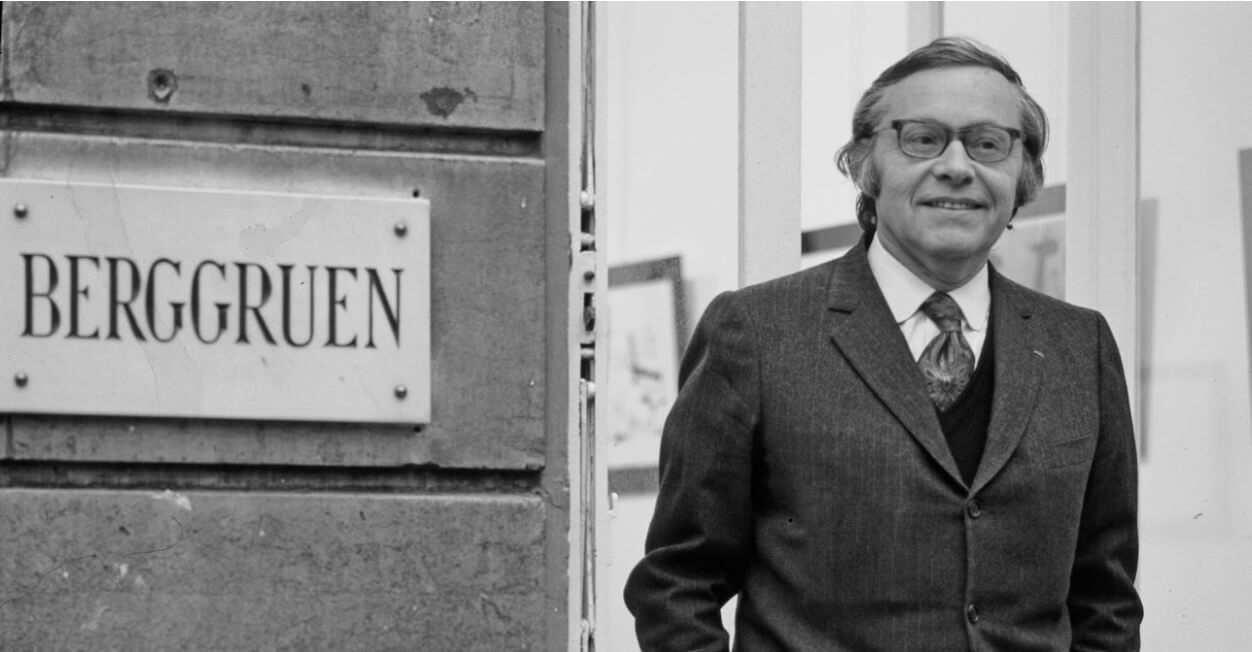He left Berlin with 10 marks in his pocket — he came back with an art collection worth hundreds of millions
Heinz Berggruen led a life on the road and on the run before he brought his artwork back home

Heinz Berggruen in front of his gallery. Photo by © Berggruen Archive. Photo: U.H. Mayer, Düsseldorf
You’ve probably never heard of a German-Jewish art dealer and collector named Heinz Berggruen, but if you happen to be in Paris this fall you might want to visit the Orangerie Museum to find out about him.
“Heinz Berggruen, a Dealer and his Collection” features works by Picasso, Matisse, Klee, Giacometti, Cezanne and Braque. But it’s not just the 90 works on display from Berggruen’s large collection that will attract you. It’s the story of the Berlin-born Berggruen himself, who fled Hitler in 1936 and then came back 60 years later to provide the city and country that had rejected him and murdered millions of his co-religionists with the treasures he had accumulated — about 300 works, worth many millions of dollars, created largely by artists the Nazis had denounced as degenerate. And who saw them housed in a building that Berlin had provided especially for the artworks.
“The symbolic gesture to choose the very city that had thrown him out was very much seen as a sign of reconciliation,” said Gabriel Montua, director of the Museum Berggruen in Berlin and co-curator of the exhibition. Berggruen had “this generosity to say I’m coming back and I’m bringing this world-class collection,” which the city “definitely needed because there were hardly any Picassos or Matisses in Berlin’s collection”
Berggruen was born in 1914 in Berlin to a middle-class Jewish family. “They had a stationery shop,” Montua told me on a video call. “They were assimilated Jews. The father had won the Iron Cross in the First World War so they felt very well-connected in a patriotic sense to the city and to the country.”

Berggruen’s first professional aspirations had been “much more literary,” Montua said. “He studied literature. He went to France to study. He was trying to become a journalist.” When Berggruen returned to Berlin, Montua said, he became more aware, at least according to his own writings, “of what was going on in Germany” after the Nazis had taken power.
“If you read his autobiography,” Montua said, “he says the reason why he then decided to leave Germany was that he didn’t see any professional future. In the articles he wrote he could not sign with his full name anymore, just with his initials, because of anti-Jewish laws that took effect. He said that for him that was the trigger.”

But in Berggruen’s writings there’s an additional awareness, Montua added. “There was a touching report from some relatives in some small town in Germany about an uncle who went swimming every day. One day he suddenly found the pool emptying itself and a Nazi shouting at him that he had to go because the Jew was polluting the water. He left with his head down.”
Berggruen immigrated to the United States in 1936 and won a scholarship to the University of California at Berkeley. It was in California that his interest in modern art truly began, Montua said.
Berggruen wrote articles for the San Francisco Chronicle and became an assistant to the director of what is now the San Francisco Museum of Modern Art, working with Diego Rivera on an exhibition — and having a brief affair with Frida Kahlo.
In California he purchased his first artwork, a Paul Klee watercolor, from a fellow immigrant. He became an American citizen, and after World War II, returned to Germany where he worked in the cultural division of the U.S. Army and worked on a German-language publication modeled on Life magazine.
As an American soldier, Berggruen “was able to move freely within the sectors of Germany under occupation and also go abroad,” Montua said. Eventually, Berggruen opened a small shop in Paris focusing at first on rare books and prints, and then, on the rue de l’Universite, “not even one kilometer away from the Orangerie,” his art gallery.
Renowned Dadaist Tristan Tzara (born Samuel Rosenstock) introduced Berggruen to Pablo Picasso, whose works became part of his growing dealership and collection. He loaned his roughly 300-work collection to Berlin in 1996, and then in 2000 sold it to the German state for, according to his 2007 obituary in The New York Times, $120 million, which he said was 1/10 its worth.

Berggruen “was always very polite and very reserved,” Montua said, and his life “was always on the move, one forced exile in 1936 and then his move from the United States where he established himself to France as a deliberate exile. He was always moving around. It’s important to know this background of his always being on the road.”
After retiring from his gallery’s activities in the 1980s, “he concentrated much more on his own collection,” Montua said. “He was looking for a permanent home for it. He could not put all the work up in his own apartment. It was rare that he could see all the works together. It was great for him to have an exhibition in an exhibition space where he could host these works.”
He first worked with Geneva’s Art and History Museum, and then the National Gallery in London before he brought his collection to Berlin at what would eventually be renamed the Museum Berggruen, which is part of the National Gallery of Berlin. According to Montua, “It was Berlin that actually approached him and said ‘well, you know, we have a very beautiful museum building to offer you.’”
In a speech opening the museum, Montua said, Berggruen recalled that he had left Berlin “with only 10 marks in his pocket” — and now he was back, Berggruen said, “with this collection worth more than 10 marks.”
“Heinz Berggruen, a Dealer and his Collection” will be on display at the Orangerie Museum until Jan. 27.
A message from our Publisher & CEO Rachel Fishman Feddersen

I hope you appreciated this article. Before you go, I’d like to ask you to please support the Forward’s award-winning, nonprofit journalism so that we can be prepared for whatever news 2025 brings.
At a time when other newsrooms are closing or cutting back, the Forward has removed its paywall and invested additional resources to report on the ground from Israel and around the U.S. on the impact of the war, rising antisemitism and polarized discourse.
Readers like you make it all possible. Support our work by becoming a Forward Member and connect with our journalism and your community.
— Rachel Fishman Feddersen, Publisher and CEO





























